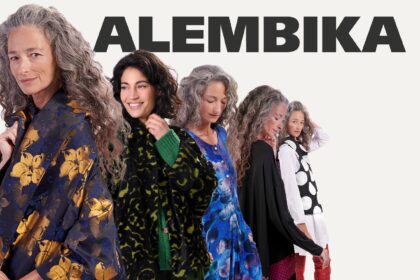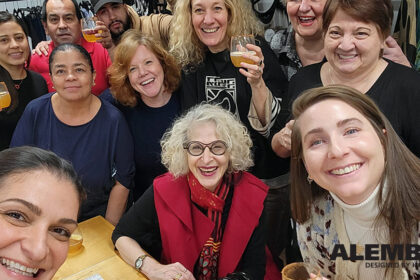
Mixing her daughter’s childhood drawings with famous works of art, drawing inspiration from her father’s sculptures, and ending the day with a view of the sunset—we visited the fashion designer at home
One of the first objects one finds in fashion designer Hagar Alembik’s home is a chiseled sculpture made by her father, sculptor Emanuel Hatzofe, who died last July at age 90. Alembik, wearing a black dress that has become a uniform of sorts, says she views her career as an inter-generational collaboration with her father and his artwork.
“My father worked with basalt, with all its power and tenderness,” she says. “I got to clothing through sculpting and 3D. Where my father turned to basalt, I turned to fabric. He chose a hard material and I chose a soft one. The amazing thing is that my father imbued the stone with softness. People like to caress his statues. We both investigated the boundaries of form, he through sculpting and I through fashion design, and both of us ended up at the same place.”

Since completing her studies at the Shenkar College of Engineering and Design’s Fashion Department in the late 1980s, Alembik has been one of the most prominent fashion designers in Israel, defining local couture through her work: a combination of soft, flowing fabrics appropriate for the local climate with an eclectic color and texture scheme reminiscent of Israeli street style. In recent years she has marketed her work successfully around the world, enjoying good fortune after a difficult period that took place when she was pushed out by Hagara, the brand she’d founded.
Alembik’s eclectic design style can be witnessed in every corner of her home: paintings by famous artists such as Pinchas Cohen Gan and Avshalom Okashi alongside drawings by anonymous artists acquired in flea markets around the world; brilliant textiles scattering spots of color all through the space alongside a monochrome sofa from the Habitat interior design store.


Alembik’s apartment is suited for her current and future needs. It includes a spacious living room and a fully equipped kitchen (though she never cooks), a small guestroom which she is presently adapting for her eldest grandchild, and a small bedroom with an attached bathroom and a walk-in closet. Even a powerful flashlight wouldn’t help you find much other than countless black dresses, all of which she designed herself. An elevator inside the apartment leads to a roof deck overlooking Dizengoff Tower and offering a view of the city. The deck is covered with planters and recliners that Alembik can sprawl over, ending her day in front of a Tel Aviv sunset.
The asset: an 860 square foot 2-bedroom penthouse apartment.
The neighborhood: central Tel Aviv.
The tenant: Hagar Alembik, sixty-four years old.
Occupancy: five years.

Who designed this home?
The architect Uri Gur did the structural design, and the interior design was done by the architect Tammy Sigalis, who was introduced to me by my daughter. I trust my daughter’s judgment. She makes good choices. Uri set the tone of the place, but Tammy adapted it to my needs and tailored it to me, simultaneously making my desires more precise and clear.
What’s it like to collaborate with another designer when working on your personal space?
It offers another point of view and skills I don’t have. I’m able to give form to abstract things, but it’s a pleasure to work with an attentive architect who understands me and addresses my desires rather than just prove what they can do. Tammy completed me.

What was most important to you when designing this home?
It’s become a joke at this point: I have a large wooden dresser. It’s almost ten feet long and two feet deep. It’s moved with me from one apartment to the next, and I always need to find an appropriate wall for it. In small apartment that sometimes means creating a wall especially for it. When I moved here people laughed at me and told me to get rid of it, but there’s no chance, it’s been with me for years. The other thing that was important to me was having a wall for all my artwork. I got both.
Is there a connection between your design style and the architectural choices in this apartment?
I think so. Or, I want to believe so. I love lots of different things, and I love having it all, the abundance. It excites me to see objects or artworks that don’t fit together becoming friends. For example, drawings my daughter made in first grade alongside works by famous artists. Or German Expressionism next to pictures from flea markets.
What do you wear at home?
I wear nothing. None of my neighbors can see into my apartment, so no one can see a thing.




What’s your favorite spot in the apartment?
The living room sofa that I bought at Habitat a few years ago. I love to read but not in bed. I like to watch TV, to think, and ponder in comfort.
Where do you like to relax?
The expression ‘my home is my castle’ could have been written about me. When I come home I leave the day behind and relax on the sofa. As soon as I close the door behind me I’ve changed phases and I’m in a different world.
Where do you have your morning coffee?
On the way to the car.
How well does your apartment reflect your personality?
Very well, I think. Not all of my apartments have, but now I feel like I’ve finally made it.
Do you have a walk-in closet?
It’s like a secret walk-in closet because you can’t see anything inside. Everything is black.” She laughs. “But I have shoes in every color. I only wear clothes that I designed myself, but when it comes to shoes I like to spread the love and buy other people’s work.
What do you prefer to spend money on—clothes and fashion accessories or furniture and houseware?
I like beautiful things of any kind, but my pleasure mostly comes from buying artwork for the apartment and shoes.
Author : Itay Yaacov , XNET
Photographer: Inbal Marmari
Translated from Xnet article: https://xnet.ynet.co.il/articles/0,7340,L-5575284,00.html




